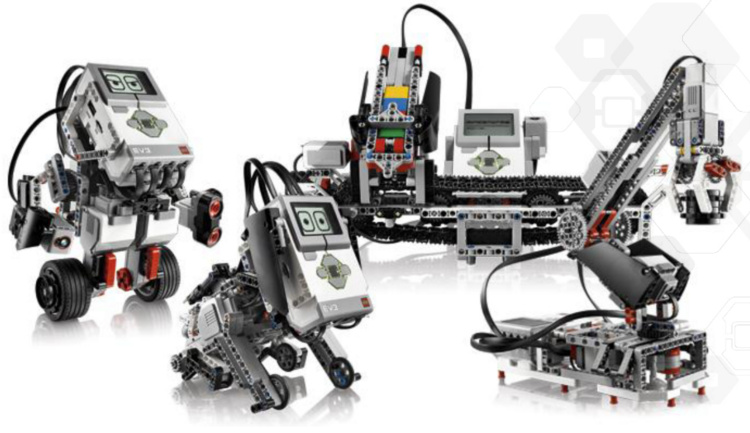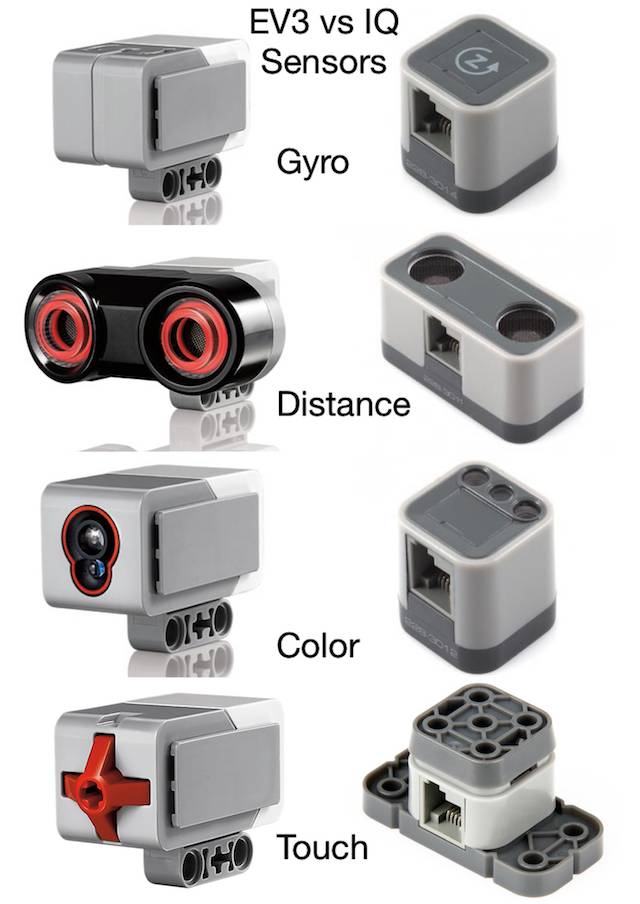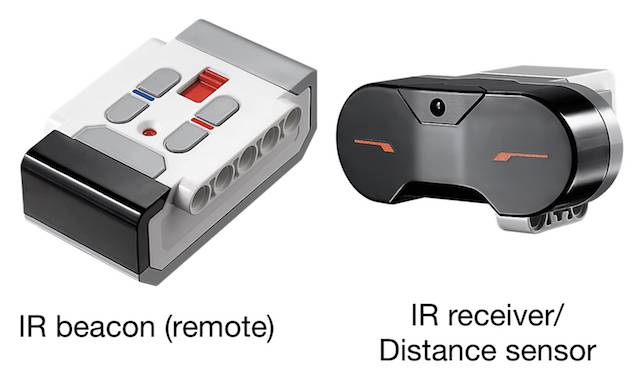Mindstorms EV3 vs VEX IQ
Let me give you the TL;DR right off the bat: if you plan on starting robotics, buy the VEX IQ Super Kit.
The company, VEX Robotics, seems more focused than LEGO, the starter kit is cheaper by a 100 USD and it has more structural parts than the EV3.
In the long run, you can move into their VEX EDR line, which offers stronger structural components (made of metal) and upgraded electronic components. Of course, if you’re really serious, I recommend looking at Arduino and RaspberryPi – you can build so much more than robots with them, but VEX is serious about their robots.
If you would like to know more details, and why the EV3 was a better choice for me in 2016 (and might be for you too) read on. If not, at least read Damien Kee’s comparison for a 20,000-foot overview.
2017: Over the past year and a half, I’ve seen LEGO commitment to Mindstorm dwindling, while VEX has been strong in their push with their platform, becoming, I think, the de facto starter platform for beginner robotics.
On my end, if I were to do this all over again and if I were to have a horizon longer than a year, I’d definitely be leaning the VEX direction.
Set Contents
Out of the entire VEX line, VEX IQ seems a direct competitor to the LEGO Mindstorms EV3 set.
Both feature similar looking plastic pieces, with wheels, axles, etc.
Both feature some sort of “brain” for the robot, aka programmable “brick”,
sensors, motors, wheels, gears, and a plethora of structures to build
the frame of your robot. However, they are in no way compatible with
each other and thus no parts can be interchanged between the sets.
EV3 comes in two separate versions. The Home or Retail version is the version you can pick up in stores at Toys’R’Us or on Amazon; the Education version, called Education Core Set, needs to be ordered online from the LEGO education store, which by the way, seems to be a separate entity from the main LEGO entity.
The two EV3 sets have some differences in included components, and the robots that can be built out of the box differ too. The structural parts are, I’d say, about 80-90% the same between the two.
| Parts | EV3 Home (#31313) | EV3 Education (#45544) | VEX IQ (Starter kit) |
|---|---|---|---|
| Structural | 550+ | 540+ | 850+ |
| Motors | 2 large, 1 medium | 2 large, 1 medium | 4 |
| Sensors - Touch/Bump | 1 | 2 | 2 |
| Sensors - Distance | 1, Infrared | 1, Ultrasonic | 1, Ultrasonic |
| Sensors - Color | 1 | 1 | 1 |
| Sensors - Gyro | 0 | 1 | 1 |
| Sensors - Rotation | 0 | 1 | 1 |
| Brain | ARM 9 | ARM 9 | TI Tiva ARM Cortex-M4 |
| IO Ports | 4 in, 4 out | 4 in, 4 out | 12, self-detecting |
| Brain Interface | USB, BT, MicroSD, (can attach WiFi dongle) | USB, BT, MicroSD, (can attach WiFi dongle) | USB |
| Controller | IR Remote or iOS and Android apps | IR Remote or iOS and Android apps | Video-game like, available separately |
| Power | 6 x AA | 2050 mAh LiIon battery | 2000 mAh NiMH rechargeable |
| Software | LEGO Mindstorms based on LabView | LEGO Mindstorms / LabView | Modkit for VEX, a Scratch-like environment, or [RobotC for VEX][rcv], a C-like programming language |
| Storage | No | Yes | Yes |
| Price | $349 | $349 | $249 |
I hope the table above makes two things clear:
- The VEX IQ is a better deal
- Of the two EV3 sets, the EV3 Education set is the closest match to the IQ.
Given the latter, I will mostly compare the VEX IQ and the Education sets, but call out interesting features from the Home set.
Robots and Instructions

All three kits have about the same number of robots that can be built out of the box with the starter kit, but within those robots there seem to be more variations on the EV3 side: the EV3 instructions for a given robot also offer adaptations in sensors and secondary attachments; it makes it easier to build a robot with slightly different abilities while keeping 98% of the frame already built.
On a personal level, I feel that the robots you build with the EV3 set, both Retail and Education, are better looking than the robots you build with IQ set (I think HEXBUG is trying to fix some of this). While that might sound shallow, consider that if you have kids involved, having cool robots is a significant plus.
Who could resist the adorable Puppy robot (Education set)?
However, in looking over the instructions, I had an easier time following VEX IQ’s than EV3’s. I also like the tips that you get at the beginning of the build instructions, e.g. “Quickly remove Connector Pins by pressing a VEX IQ Beam against the back of the Pin and pulling it out” or “Rubber Shaft Collars become softer and easier to install if they are warmed by holding them in your hand for 15-30 seconds”.
For beginners, those kind of tips can save a lot of time and frustration.
VEX IQ bots
EV3 Home robots
EV3 Education robots
I couldn’t find one video of all the robots you can build with the Education set, only videos of individual robots, so here is collage of the various robots.
And once you add the Education expansion set:
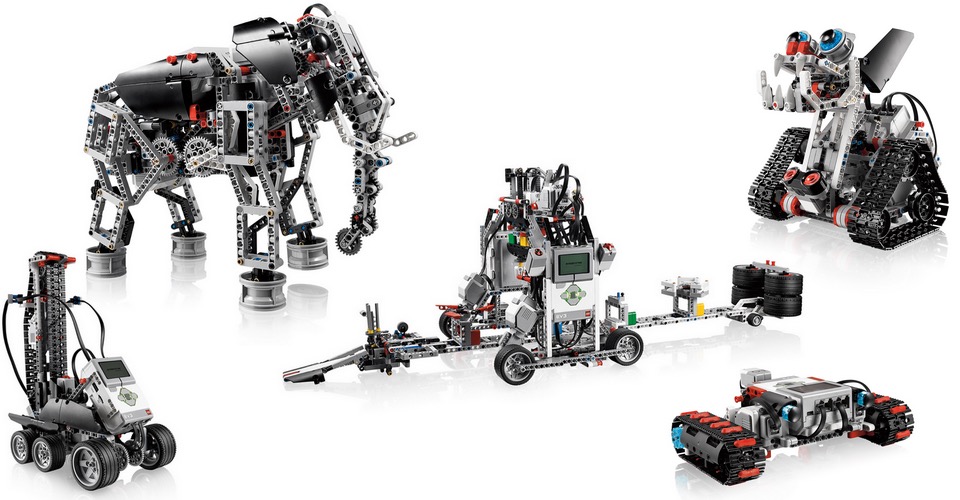
The presence of instructions is an individual preference, but all else being equal I’d rather have more instructions and not use them. In this, the EV3 sets do a great job.
Structural Components
I haven’t actually tried the IQ set – I’m relying on information from friends and the web – but people with experience with both kits say that it’s easier to build (or rebuild) with VEX IQ. For one, it seems to have some larger plates and beams which should make it easier to build larger robots. The IQ set has thinner pieces that require more bracing, but they also allow bending, which would expand the range of possibilities, and the elasticity makes them less likely to fall apart when bumping into things or falling off obstacles.
To a certain degree, VEX IQ is also compatible with the VEX EDR, which would allow you to replace some of the structural components with stronger metal pieces from the EDR.
On the other hand, the EV3 uses LEGO Technic pieces, which opens
the door to a whole large world of kits and builds, including
the possibility of automating some of the Technic sets.
Mmmm Container Truck + Volvo Loader…
…I’ll be in my bunk.

Furthermore, one can also add regular LEGO blocks in the mix, which is a ridiculous reason to pick the EV3 over the IQ, but it might allow you to include younger children into your building activities.
Gears
When it comes to gears, it becomes a bit more difficult to make a straight comparison.
The VEX IQ feels like it has the upper hand with a host of regular gears, from 12 to 60 teeth in a variety of colors, to sprockets and chains, to racks, worms, and slides, to differentials.
The EV3 has a similar range of gears (from 8 to 40 teeth), sprockets, racks, etc, but also includes a slightly different take on turntable gears: whereas the IQ is smooth and ball-bearing, the LEGO variant has teeth so it can be used both as a turntable and as a reduction gear. I feel the sprockets and chains in the VEX IQ are better than the LEGO equivalent and there’s a a better set of pulleys too.
Worth mentioning that with the EV3 you have access to the full set of Technic gears (read Sariel’s tutorial on the topic).
Wheels and Motion
Both EV3 kits come with a decent set of wheels, and there’s an insane number of wheels and tires you can get from Technic set, but of course they don’t matter much when you only have 3 motors, 4 tops.
The Home kit comes with a pair of fixed-size rubber tank tracks; the Education kit has an link-based chain that can be used to build either tracks (used by the Tank Bot and Znap from the Expansion set), an assembly-line (Color Sorter from Core set) or even creatively in the Stair Climber bot.
The Education set also comes with one interesting part: a ball-wheel; it makes it easy to build robots that can turn using only two motors for the driving wheels as the ball-wheel would serve as the third, non-powered wheel.

Unsurprisingly, the VEX IQ set does it one better, with cool omni-directional wheel, a complete set of tracks with various inserts, and even a separate set of chains and sprockets.
My good friend Yusuke says this of the offer:
I like the VEX sprockets and chain for distributing load over large distances. No need for an idling gear to run 4 wheels with 2 motors. The chains and tank treads are adjustable in length unlike the fixed size rubber treads in the LEGO set and you can use the chains for different conveyor mechanisms by attaching different size flaps at whatever interval you want.
Electronics
The two sets offer the same type of electronics and with very similar specs, with VEX IQ’s offer being slightly better in motors. Similar to the motors, the VEX IQ sensors seem to be smaller in size, which does help in almost any construction you plan on building.
Brick
The brain, aka controller aka brick, is where they differ significantly.
The VEX IQ has 12 auto-sensing I/O ports, meaning you can connect as many motors or sensors as you want, in any combination you want, whereas the EV3 has 4 dedicated motor ports and 4 dedicated sensor ports – meaning that if you need to connect 5 motors you need to look at the 3rd party market for a motor multiplexer – $55 for 2 extra motor ports.
However, the VEX IQ is based on TI Tiva ARM Cortex-M4 Processor, with only 256K flash and 32K RAM, about the same as the old Mindstorms NXT.
The EV3 brick uses a much faster TI Sitara ARM 9 processor – the same as the Nintendo DS, NEST Thermostat, or BeagleBone Black – with 16 MB of Flash memory, 64 MB of RAM, and running at 300MHz. This has some exciting ramifications, which we’ll talk about in the Software section.
EV3 Brick allows display of images, can play sounds, and change LED color. It’s not backlit. IQ is.
From a connectivity perspective, the EV3 is better equipped out of the box: both use USB to upload programs to the brick, but the EV3 also comes with Bluetooth, which allows you to control your robot with your iOS or Android phone using the LEGO Robot Commander app.
The VEX IQ comes with a 900 MHz radio module that talks to their game-like controller; for only $13 you can purchase a Smart Radio module that enables Bluetooth 4.0 connection to the brick, and theoretically would enable the creation of a similar controller app (there is none available at the moment).
To power the brick, the EV3 Home edition takes in some 6 AA batteries. For 85 USD you can buy a 2050 mAh LiIon battery - #45501, or you can buy the better Education kit and get it for free.
VEX IQ comes with a rechargeable battery in the starter kit.
It’s similarly spec’d at 2000 mAh, but alas it’s NiMH.
You can, and should, purchase additional batteries for only $20
(4x cheaper than LEGO!).
Probably not significant, but in additional to the better battery chemistry, the EV3 set allows the battery to be charged without having to take the model apart. Of course, it all pales in comparison with the price you pay for the VEX IQ battery: you can buy a few and swap them out all day as they only take about 2-3 hours to recharge.
Motors
VEX IQ comes with 4 motors and the EV3 sets come with 1 medium and 2 large motor.
The medium-sized EV3 motor is a higher rpm, lower torque motor;
the large EV3 and VEX IQ motors are lower rpm but higher torque.
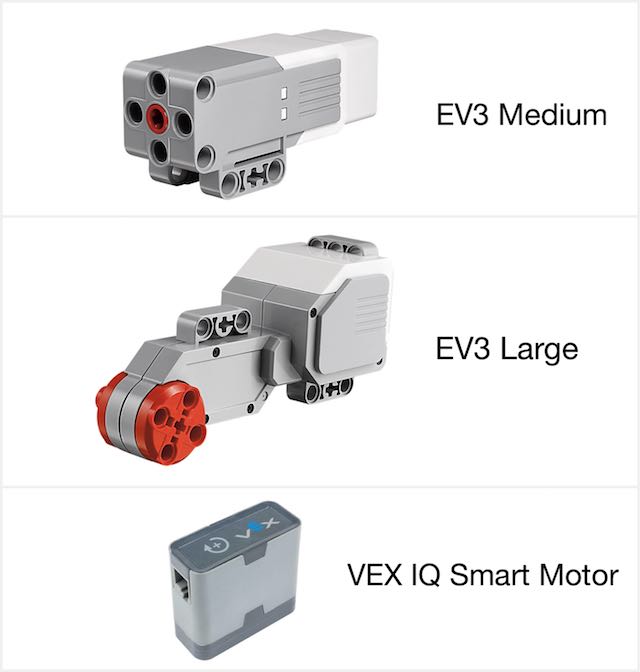
| Parameter | EV3 Large (#45502) | EV3 Medium (#45503) | VEX IQ |
|---|---|---|---|
| Servo? | Y | Y | (1) |
| Encoder accuracy | 1 deg (2) | 1 deg (2) | 0.375 |
| No-load RPM | 160-170 | 240-250 | 120 |
| No-load current | 60mA | 80mA | ? |
| Running torque | 20 N/cm = 30 oz/in | 8 N/cm = 11oz/in | ? |
| Stall torque | 40 N/cm = 60 oz/in | 12 N/cm = 17 oz/in | 41.4 N/cm |
| Stall current | 1.8A | 780 mA | 1.1 @ 7.2V |
| Sample/Command rate | 1 kHz (3) | 1 kHz (3) | 3 kHZ |
| Mechanical Power @ 4.5V, 9V, 12V | 0.43W, 1.9W, 2.77W | 0.17W, 1.15W, 1.73W | ? |
| Output power @ 4.5V, 9V, 12V | 3.1W, 6.21W, 8.28W | 1.57W, 3.33W, 4.44W | 1.4W @ ? |
| Weight | 82g | 39g | ? |
| Size (4) | Large | Medium | Small |
| Price | $25 | $20 | $20 |
Notes:
- (1): The VEX IQ motor doesn’t seem to be a proper servo (a servo will move to a position then attempt to hold that position, even without power), but it seems it can be made to hold its position under active power;
- (2): EV3 encoding accuracy can be doubled to 0.5 degrees with a small hack
- (3): I cannot find any information about EV3 motor command rates, but the sample rate for the rest of the sensors seems to be 1 kHz, so I’ll assume to be the same for the motors;
- (4): The smaller physical size of the VEX IQ engine means that it can be used in more compact builds, or in tighter spaces; the larger size of the EV3 motors means it can be part of your structure or structural reinforcement.
Thanks to Philippe “Philo” Hurbain for a lot of the research into Technic motors!
Sensors
VEX IQ comes with more sensors than the Home version of EV3 and about on par with the Education version.
Gyro Sensors
Much like the rest of the narrative, the VEX IQ Gyro is both a better and a little bit worse than the EV3 Gyro sensor #45505.
| Parameter | EV3 #45505 | VEX IQ |
|---|---|---|
| Sample rate | 1 kHz | 3 kHz |
| Accuracy | +/- 3 degrees | ? (1) |
| Max output | 440 degrees/second | 550 degrees/second |
| Price | $30 | $25 |
- (1) There’s no information about the accuracy of the IQ gyro sensor, but a post in the forums mentions 1 deg/minute drift in reading. Perhaps the EV3 has the same issue, but it’s somehow eliminated in software.
Distance Sensors
There are two types of distance sensors: ultrasonic and infrared.
The ultrasound sensor tends to be more precise at larger distances, but due to its nature it suffers when the reflecting surface is sub-optimal: curved surfaces and smooth surfaces at skew angles deflect the signal away from the receptor in the sensor; cloth and carpet-like surfaces, including drapes, allow the signal to pass through and reflect very little back.
In contrast, the infrared sensor works off reflecting light so it suffers less from these issues, however it has its own set of problems, the main one being light polution causing the sensor to only be effective at short distances.
Both types of sensors have an active scanning mode and passive receiving mode enabling the infrared sensor to act as a receiver for a remote, e.g. EV3 Infrared beacon, whereas the ultrasonic sensor can act as a noise detector.
The VEX IQ Distance sensor is ultrasonic, similar to the EV3 Education kit’s distance sensor; The EV3 Home version comes instead with an Infrared sensor (pictured above).
It’s worth pointing out that the eye-like construction of the ultrasonic sensor, with an emitter and a receiver side by side, causes detection bias towards the side with the transmitter.
| Parameter | EV3 Ultrasonic #45504 | EV3 Infrared #45509 | VEX IQ |
|---|---|---|---|
| Range | 1-250 cm = 1-100 in | 50-70 cm = 20 | 1-300cm = 1-120 in (1) |
| Accuracy | +/- 1 cm = +/- 0.394 in | ? | ? |
| Receive Mode | Yes | Yes (2) | ? |
| Price | $30 | $25 | $25 |
- (1) marketing copy; after it was pointed that max distance seems to be 610mm in RobotC and 500mm in ModKit, in an email exchange with a support person, VEX recognized that they need to update the web page to read a 2 to 18 usable distance,
- (2) - up to 2 meter = 6 feet distance from beacon
Color Sensors
The kits come with sensors capable of detecting multiple colors, but also measure relative ambient light level (comes in handy for follow-the-line robots).
The VEX IQ color sensor is the superior one here:
- can detect 12 simple colors: red-violet, red, dark-orange, orange, dark yellow, yellow, lime green, green, blue-green, blue, dark blue, violet;
- RGB - 256 levels each;
- senses color hue;
- ambient light level;
- costs $25 (comes in the kit, but for replacement purposes…).
The EV3 color sensor costs $40 for a replacement, and has lower spects on the detection level:
- only 8 colors: black and white (1), or between blue, green, yellow, red, white and brown;
- samples at 1 kHz;
- can detect ambient light level.
Note (1) - professing color detection of black and white seems a bit like cheating in specs, as I’m sure the VEX IQ detects the same. That would put the IQ sensors at 14 colors vs 8 for the EV3.
Bump aka Pressure Sensors
There are bump sensors in both kits and they function the same; they take a low pressure to trigger and can register three states: pressed, released, and “bumped” (quick press followed by release). In both cases you can attach other elements to them, e.g. a cross-axle, to perhaps increase their range.
It’s puzzling though why the VEX IQ bump sensor costs only $5 while the EV3 bump sensor costs $20 - four times the price.
Note that the EV3 refers to the sensor as a “touch sensor”, but in the context of modern parlance where touch typically means capacitive touch sensor, I feel bump sensor is a less ambiguous name.
LED Signaling
In terms of signaling, the EV3 relies on the brick: it can display text and images, but you can also program the LEDs surrounding the control buttons to change to one of three colors: green, amber, red, and to blink at various rates.
In contrast, the VEX IQ set offers a combination Touch sensor with LED that is truly touch-triggered, but it can also use the embedded LED lights to display some 16 million color variations, in addition to being able to blink at specified rates.
Offering a separate LED signaling device means that not only it can be placed in a prominent place, but that more than one can be attached to the controller.
Cables
Both kits use, apparently for safety reasons, proprietary connectors on their cables. They are modeled after a 6P6C plug (telephone plug), but the EV3’s latch is right-offset, whereas the VEX IQ is left-offset.
I really wish they had use the same connector, because unsurprisingly the VEX IQ cables are cheaper than the EV3: $10 for 6 cables vs $15 for 7 cables.
Both sets have extra long cables (1-2 m = 3-6 ft) available for purchase, through VEX Robotics in the IQ case, and 3rd parties in the EV3 case.
Third Party
Finally, the EV3 shines in that it has quite a
rich
3rd-party
parts market -
there’s even a RaspberryPi replacement for the brick:
BrickPi
(and a not-too-expensive BrickPi Starter Kit).
VEX Robotics is currently the only supplier for
VEX IQ, but they have good offerings at very sensible prices.
Software
There are two dimensions to consider when it comes to the software part of your robot: by far the more important is the programming part, but being able to design and share your designs with others is something communities thrive on.
2016: To be honest, in terms of features and pricing, EV3 has the upper hand.
By a wide margin.
2017: With Vex offering the software for free as of 2017,
I cannot state Mindstorm’s superiority anymore in this aspect.
Quite the contrary, I believe now that Vex is better positioned
as a long-term platform, particularly in terms of software.
Programming
The default programming environment for the EV3
is LabView-based, using a metaphor of various types
of blocks to represent sensors, actions (motors, speaker),
data operations (on variables), instructions (loops, etc),
and some advanced blocks (manage files, BT, system).
It also comes in two versions,
a Home version and an Education version, both free, purposefully
mirroring the two EV3 sets because each version builds
robots specific to the parts that come with the respective sets.
This software is available for OS X and Windows,
and there’s also a version of the software for iOS and Android,
although the latter has some limitations in what blocks it can use.
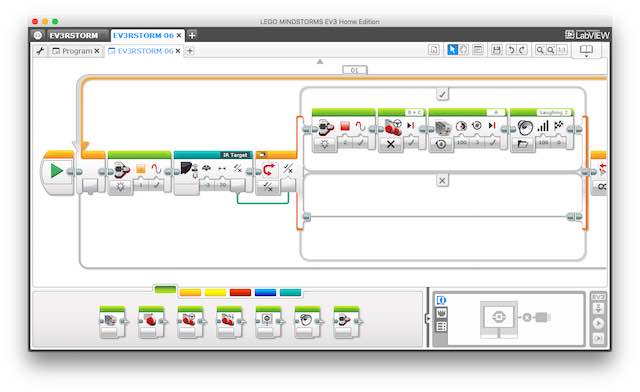
The apps, in all their variants contain both step-by-step building instructions, as well as the programming environment.
2016 - See note below for 2017: The VEX IQ has three options, none which are free, from $50 for ModKit, a Scratch-like visual language (Windows & OS X), to $75 for easyC, which is a more typical programming language (Windows only), to $80 for RobotC for VEX, which supports both approaches, but it’s also Windows only.
2017: As of 2017 Vex offers the software free with purchase, which makes considerably easier to recommend over Mindstorm’s more basic software.
Due to the considerably larger memory of the EV3 brick and the microSD port, it’s possible to actually run a full-blown distribution of Linux on the brick; ev3dev is one such distro that ships with full version of Python, including the modules and libraries necessary to program your robots.
Then there’s LeJos - Java based, a veteran in the field of Mindstorms programming
going back to the NXT days; and there’s even a RobotC version for EV3
(unfortunately it’s Windows-only).
Again, you have a full-blown version of Linux,
so pretty much anything you can do on Linux, you can do on the brick.
One interesting software component that the EV3 set comes with, although only in the Education set, is a datalog block.
This allows the brick to record high-sample sensor data, for example
data from a temperature sensor,
or truly any of the other sensors.
The data can be obtained and viewed in the LEGO Mindstorms app
either on the fly, when the brick is connected to the computer,
or at a later time.
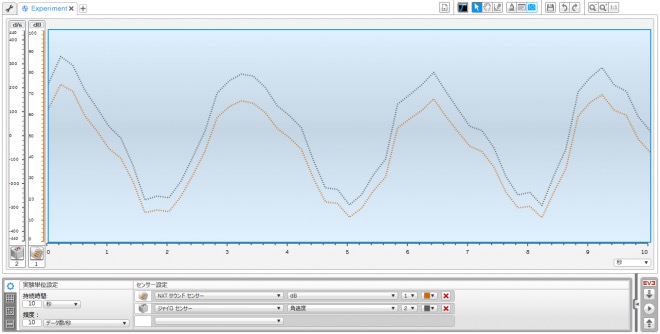
Design
On the CAD front, LEGO has the LEGO Digital Designer aka LDD, a well liked program, with both OS X and Windows version, although it’s being discontinued as of January 2016; there’s even an open standard for LEGO CAD programs, LDraw, and quite the list of programs that can use it.
VEX IQ has SnapCAD – but it’s Windows-only. I guess sharing designs is not that big of an issue with VEX IQ users.
Competitions
This is based on pure observation, but robotics competitions seem to be either dedicated to a certain vendor’s wares, or more generic robotics competition that favor custom builds and custom programming.
LEGO has FIRST LEGO League Jr, FIRST LEGO League, and SuGO - LEGO Sumo.
VEX IQ has the VEX IQ Challenge,
but it also seems to be the kit of choice for middle and high-school competition.
2015–2016’s Bank Shot challenge
looks like a lot of fun.
Note: You’ll probably want to buy the VEX IQ Competition Add-On Kit. It’s only $100 but it expands your kit significantly.
There are more competitions, but the kits used seem considerably above the EV3 and IQ levels.
Final Words
Between included components and low prices, VEX IQ feels like the right generation platform for entry-level robotics education or competitions.
The EV3 is a power house when it comes to processing capacity and the availability of components, both in loans from the Technic sets as well as third parties like Mindsensors or RobotShop.
As a software engineer doing this for fun, the processing power available to the EV3 brick was ultimately more attractive to me than the benefits offered by the VEX IQ set.
Stay tuned for a post on which of the EV3 sets I decided to go with and why.
Thanks
Much of this article wouldn’t be possible without the research and writing of Laurens Valk of Robot Square, Philippe “Philo” Hurbain, Damien Kee, and many others.
A great many thanks to Yusuke Morita for his advice, enthusiasm, and ability to carefully review looooong posts without dying of boredom.
